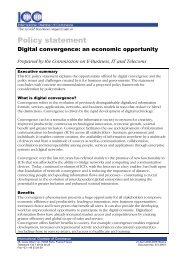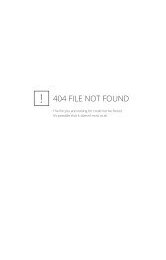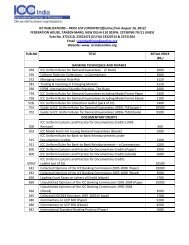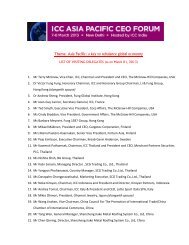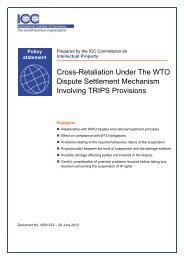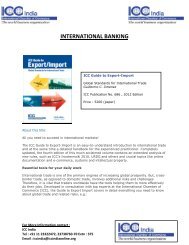2013 - ICC India
2013 - ICC India
2013 - ICC India
- No tags were found...
You also want an ePaper? Increase the reach of your titles
YUMPU automatically turns print PDFs into web optimized ePapers that Google loves.
56<strong>ICC</strong> BANKING COMMISSION | <strong>2013</strong> GLOBAL RISKS TRADE FINANCE | APPENDIX B■■■■For example, the proportion of exposures expiring unpaid would belower or higher in a recession. On the one hand firms may be morecareful about completing documentation in order to ensure they arepaid under the L/C 120 . But on the other hand, in more severe economiccircumstances, firms may move to default more quickly, and maytherefore not have sufficient time to submit documentation priorto default.For some products, such as L/Cs, the drawn amount will continue to bethe full amount so will not be cyclical. However, for others where thedrawn amount is not typically 100% of the exposure, this may be cyclical.Although the Trade Register allows analysis of the proportion oftransactions rejected on first presentation of the documents, as well as theproportion that expire without being paid at an aggregate level, we cannotderive an estimate of the EAD or CCF at this stage because:■■■■■■It is not possible to observe these parameters on defaulted firmsspecifically (which would be required when determining for Baselpurposes).From discussions with participating banks, these two measures donot necessarily provide the ideal way of assessing of the proportion oftrade finance products that convert. This is because the former mayunderestimate the conversion rate 121 , whilst the latter may not capture allcases where banks do not make payments on the product.Even if these figures provided a good measure of the proportion ofexposures that convert, for some products an estimate of the percentageof the limit drawn at default would need to be determined.In order to derive appropriate figures in future reports, additionalinformation would be needed. Likewise the most appropriate treatment ofcases that do not convert would need to be discussed with regulators inorder to ensure a possible aligned perspective.Loss Given DefaultAs noted above, firms using the foundation IRB approach base their LGDestimates on the parameters specified by regulators. Although these dopermit the recognition of guarantees and some forms of collateral (primarilyfinancial collateral, but also purchased receivables), in reality very little of thecollateral backing trade finance transactions will be recognised. Likewise,given the anecdotal evidence that firms pay their trade finance exposureseven where they are in default on other exposures, the LGD for unsecuredexposures within the foundation rules may fail to adequately reflect theproportion of customers who fully repay on trade finance exposures,although this may in part be reflected through the CCF for some products.As mentioned above, advanced IRB banks may be able to address bothof these issues through their estimation approach, if they have sufficientdata available. For advanced IRB firms, the Basel II rules enforce a fewrequirements, in particular “the definition of loss used in estimating LGDis economic loss. When measuring economic loss, all relevant factorsshould be taken into account. This must include material discount effectsand material direct and indirect costs associated with collecting on theexposure. Banks must not simply measure the loss recorded in accountingrecords…” 122 .



